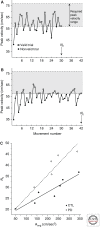Motor control abnormalities in Parkinson's disease
- PMID: 22675667
- PMCID: PMC3367543
- DOI: 10.1101/cshperspect.a009282
Motor control abnormalities in Parkinson's disease
Abstract
The primary manifestations of Parkinson's disease are abnormalities of movement, including movement slowness, difficulties with gait and balance, and tremor. We know a considerable amount about the abnormalities of neuronal and muscle activity that correlate with these symptoms. Motor symptoms can also be described in terms of motor control, a level of description that explains how movement variables, such as a limb's position and speed, are controlled and coordinated. Understanding motor symptoms as motor control abnormalities means to identify how the disease disrupts normal control processes. In the case of Parkinson's disease, movement slowness, for example, would be explained by a disruption of the control processes that determine normal movement speed. Two long-term benefits of understanding the motor control basis of motor symptoms include the future design of neural prostheses to replace the function of damaged basal ganglia circuits, and the rational design of rehabilitation strategies. This type of understanding, however, remains limited, partly because of limitations in our knowledge of normal motor control. In this article, we review the concept of motor control and describe a few motor symptoms that illustrate the challenges in understanding such symptoms as motor control abnormalities.
Figures




References
-
- Albin RL, Young AB, Penney JB 1989. The functional anatomy of basal ganglia disorders. Trends Neurosci 12: 366–375 - PubMed
-
- Alexander GE, DeLong MR, Strick PL 1986. Parallel organization of functionally segregated circuits linking basal ganglia and cortex. Annu Rev Neurosci 9: 357–381 - PubMed
-
- Ballanger B, Thobois S, Baraduc P, Turner RS, Broussolle E, Desmurget M 2006. “Paradoxical kinesis” is not a hallmark of Parkinson’s disease but a general property of the motor system. Mov Disord 21: 1490–1495 - PubMed
-
- Bastian AJ 2006. Learning to predict the future: The cerebellum adapts feedforward movement control. Curr Opin Neurobiol 16: 645–649 - PubMed
-
- Bastian AJ, Martin TA, Keating JG, Thach WT 1996. Cerebellar ataxia: Abnormal control of interaction torques across multiple joints. J Neurophysiol 76: 492–509 - PubMed
Publication types
MeSH terms
LinkOut - more resources
Full Text Sources
Medical
